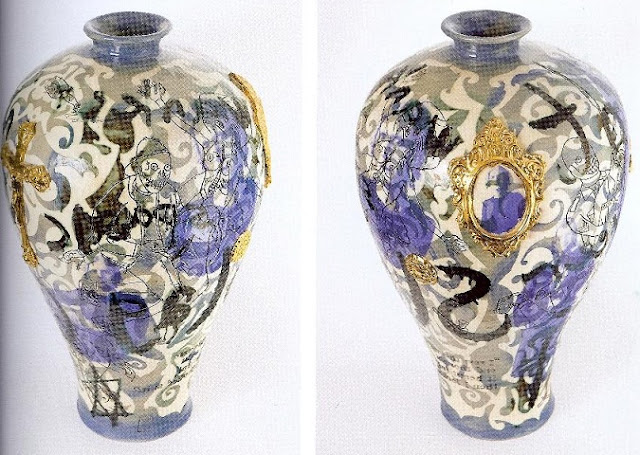Art Throb #4: I saw this vase and thought it beautiful, then I looked at it, by Grayson Perry
Grayson Perry, I saw this vase and thought it beautiful, then I looked at it, 1995
Glazed ceramic, 17 1/4 x 11 "
Following on from seeing Grayson Perry's Tomb of the Unknown Craftsman exhibition last week, I thought I'd post a bit more about why I admire his work so much. I came to it through my fascination, I suppose, with him. Both he and Eddie Izzard are examples of people who are as open and uninhibited in their transvestism as they are in their work. A large amount of fearlessness is essential in creativity, and perhaps once one has come out as a transvestite, anything seems possible.
In my opinion, no one else has done so much to reinvent a craft as Grayson Perry. He himself admits that his chosen medium, clay, is one that he professes to love due to it being ‘held in such low esteem in the art world’. There's an element of deliberate masochism in his work. It was pottery's very un-coolness – it having connotations of being evening class, second-class, outsider, feminine, ‘other’ – that originally drew him to it. Even his technique of coiling sausages of clay is in defiance of the sacred art of throwing clay on a wheel. That said, his work is anything but 'gran's sideboard and mantlepiece'. In the case of the vase above, in applying such a title as I saw this vase and thought it beautiful, then I looked at it, Perry is showing an awareness of the impact of his work on the viewer.
Indeterminate arabesque swirls stencilled in blue against a white background (an iconic colour combination recalling Delft and Wedgwood pottery) mingle with romantic, blue-tinted images from the past. Yet this inoffensive imagery is juxtaposed with crudely scrawled graffiti of the most offensive and base vernacular – the words ‘wanker’, ‘slag’, ‘queer’, ‘spastic’ in black lettering figure largely, as if sprayed with aerosol. This subversive calligraphy associated with the socially abject of the urban underground contrasts with the cosy, old-fashioned images of the past. So large are these words, they are incapable of being read from any one vantage point, inassimilable, yet their very presence is enough to fill the viewer with unease and dread. Their looming emanates from a distance, inciting anxiety, fascinating desire, signifying the ignored presence of the constantly-threatening presence of abjection, linguistic repression and moral panic, as hierarchies and order are destabilised. Emerging from this miscellaneous ephemera, depictions of violent pornography, scratched and scored into the clay slowly come into view: a grinning, baseball-capped skeleton, reminiscent of the grim reaper, masturbating while about to carve off the breast of a crucified naked woman; a masked gunman carrying the body of a hanged policeman. Here the inseparability of sex and death is rendered explicit.
Meanwhile, floating among this hallucinatory explosion of the grotesque and the familiar is the Star of David and a golden crucifix, symbols of spiritual refuge, present yet seemingly uninvolved, while at the centre of it all, pride of place among this abject mess, is the artist himself, yet not himself – as Claire, his transvestite altar ego, dressed in Victorian garb – looking out from a place of safety, segregated within an ornate oval-shaped gold baroque-style frame, which could be a picture frame, or that of a mirror. Like the religious symbols, he is both part of the pot and separate from it. His gaze could be staring out, or it could be a reflection of one looking in. Either way, it is indirect, askance, ambiguous. The viewer’s bouncing, oscillating gaze is duplicated in that of the artist’s; he too does not know where to look.
The slim, dainty base, full belly, round shoulders, tiny neck and pouting mouth of this vase promise a comfortable viewing experience. Yet this pot is not what it appears to be. What is alluring at first glance betrays initial expectation. A thing of beauty has been violated, yet the graceful form of the pot saves it from complete devastation.
Who'd have thought there'd be so much to a pot?



Comments
Post a Comment